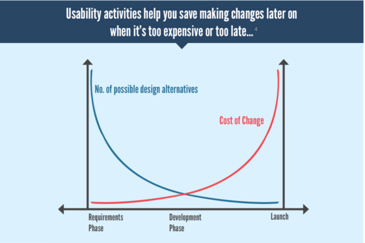

Everyone knows the value that user research can bring to product development, right? Whether you own a wine shop or work for a company with a large digital presence, it is simply smart business to understand the needs, desires, and objectives of your customers and prospects. Once you understand what makes them buy, and what satisfies them, you can incorporate this into a sound strategy to deliver the best value proposition. Ensuring that the experience you create meets, and better yet exceeds, your customers’ expectations is the holy grail.
For years, research has validated the fact that improving the usability of a site increases conversion, reduces customer service calls, increases customer satisfaction, and boosts loyalty. Additionally, it’s been proven that thoughtful integration of UX testing into the development process can reduce costs, minimize development time, and ensure the end product more closely aligns to the user's mental model.
We see success stories and specific case studies where companies have championed how user research turned things around (e.g., Airbnb) or how it is essential to their success (e.g., USAA, Amazon). Online and at conferences throughout the world you will find research conducted by intelligent individuals that breakdown the ROI of UX and have metrics to back it. There are infographics, reports you can buy, and an endless list of related content.
But, knowing the value of UX and making a compelling business case for conducting sound UX research is merely part of the equation. The impact of UX research, and UX thinking, is directly related to how effective you are at integrating it into the fabric of your organization. We’d like to share some common misconceptions and obstacles that impede the successful integration of UX and provide prescriptive ways we’ve attempted to solve them:
MISCONCEPTION: User research is costly and/or time consuming. “It can’t be done at the agile pace required.”
FACT: User research can and should be part of the development process. Understand that not all user research needs to be formally conducted in the lab with a formal or tangible finished product. Your customers are resilient, capable of understanding loose concepts, and can provide insights from ideation to product deployment. Ideally, UX lives within your iterative design process.
Key Lime Interactive (KLI), for example, has a program called QuickInsights™ ,which is designed to take the shape of the product development project that you assign it to. This program injects user testing, provides actionable insights, and harmonizes next steps with your team all within a one-week period so development teams can continue moving at an agile pace.*
OBSTACLE: The belief that internal stakeholders know what the customer wants. “Customers don’t know what they want, but I know what they want.”
FACT: You are NOT your customer: It is too easy to think that as the subject matter expert you are best equipped to ideate and come up with the next innovative solution. There may be some truth to that, but recognize the value of perspective and the unique journey that each of your customers brings with them. By virtue of understanding the business objectives you are trying to achieve, and how the system is supposed to work, you have developed an intimacy with the product that “outsiders” don’t have. Even the most well-intentioned designer/developer/product manager can fall into the trap of operating with an unconscious bias towards what an experience should be. Remember, one of the intrinsic benefits of UX research is collecting data from various sources to ensure you are making the most informed decision possible.
OBSTACLE: There is an unwillingness to hear/discover what you’ve built is flawed. “We’re already too far down the development process to turn around now.”
 *Source: http://bit.ly/1t6a1rk
*Source: http://bit.ly/1t6a1rk
FACT: My baby isn’t ugly: You’re right, it’s not ugly, but that doesn’t mean it’s perfect either. Finding out what critical adjustments need to be made is ideal insurance for long-term product success. This holds true whether you’re closing in on your launch date, or just starting to build. In most cases, you have one opportunity to get it ‘right’, so delaying launch to ensure the user experience matches your user’s mental model could be the smartest decision. Don’t take these new learnings as an indictment on the quality of your work, but rather as an opportunity to refine the experience so you can delight your customers.
OBSTACLE: Usability insights are not effectively shared throughout the organization (across various teams). “Why does it feel like we heard this before? Are we still making the same mistakes?”
FACT: Socializing and reapplying information learned about your users and how they behave in a given scenario is among the most difficult issues UX professionals face. Many mature UX organizations are decentralized in that they work in silos, a.k.a. Pods, a.k.a. Product Teams, and sharing knowledge becomes an afterthought to uncovering insights and implementing fixes.This, however, is not an excuse to let these valuable insights fall through the cracks. To address this problem, we’ve come up with a number of solutions:
1. At KLI we have created a system to log each of the observations, related recommendations, and a severity rating aimed at communicating the frequency and impact each issue has on the experience. Each report has its own collection of findings and recommendations, but we also have a running log that we update regularly. We consistently reference this log both as we are analyzing new results, but also before research is commissioned to identify if we already have the answer based on previous user feedback.
2. Another tactic we use in our reporting is to visually catalog observations as ‘repeat findings’. This affords us the necessary leverage to move this issue up the priority chain as we can show that it either happens with greater frequency than you initially realized, and/or it impacts more than a single product’s success.
3. Lastly, a practice that has proven invaluable is to create one-page executive summaries for each of the user research projects we’ve worked on so the core findings can be more easily shared. When possible, this one-pager includes an embedded video that helps “sell” what was learned. These videos, in particular, have proven to be invaluable to quickly disseminate information AND keep peers engaged.
This is not a complete list, but among the most common excuses and/or hurdles that UX professionals face on an ongoing basis. I encourage you to continue spreading the message that UX brings value and can be as nimble as it needs to be. Please use these solutions, or variations of them, to more effectively integrate UX within your organization so your business can produce experiences that consistently delight your customers.
Now, ready to incorporate UX into your organization? Not sure where to begin? Download our full guide, 10 Questions to Ask a Prospective Usability Research Partner.
*For more info about KLI QuickInsights™ contact sales@keylimeinteractive.com










Comments
Add Comment